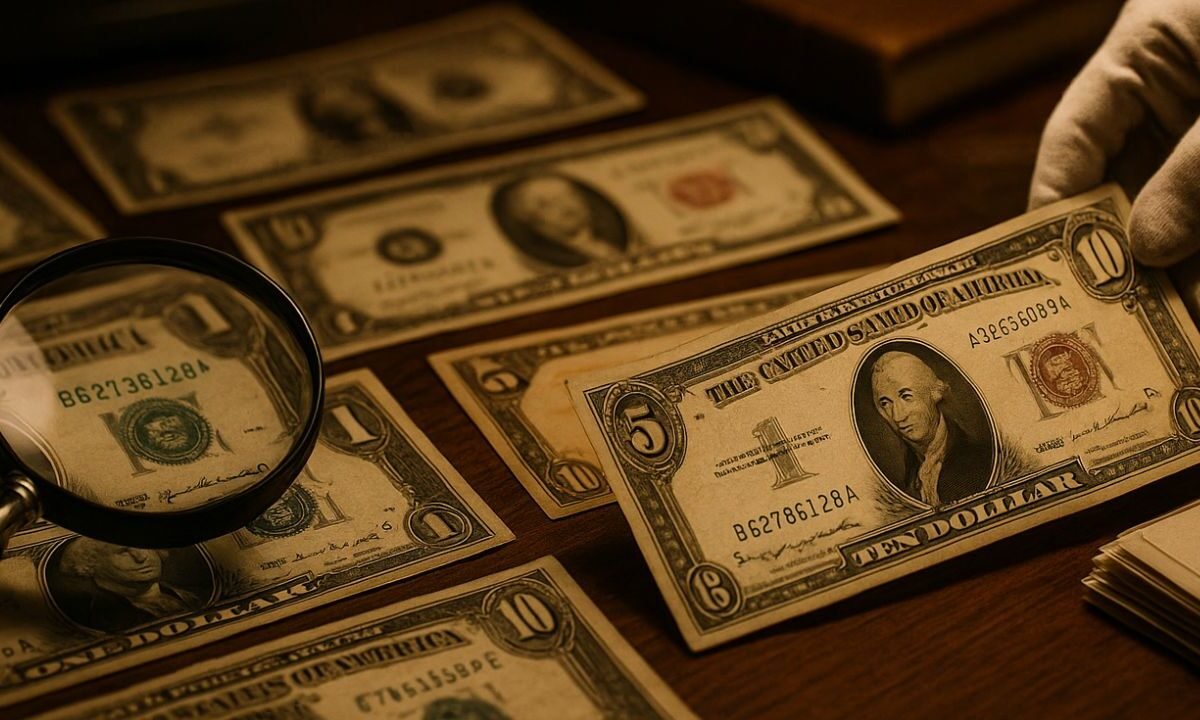Most people think coins are the main collectible items in U.S. currency — but what if the real treasure is sitting right inside your wallet?
Across the country, collectors and auction houses are paying thousands of dollars for certain rare U.S. bills that appear ordinary at first glance.
From printing errors to unique serial numbers, and even discontinued high-denomination bills, some notes are worth hundreds or even hundreds of thousands of dollars more than their face value.
With online marketplaces and auctions revealing record-breaking sales, it’s becoming clear that paper money can be as valuable as gold to collectors who know what to look for.
In 2025, interest in error notes and fancy serial numbers is stronger than ever — especially as new generations of collectors enter the hobby.
Headliners- Error Notes That Make News
Retained-obstruction errors (the “Banana Sticker” $20). A $20 bill with a banana sticker from the printer got embedded during the run and later sold for nearly $400,000—the record for any error banknote.
If you see parts of the seal or serial number printed atop a foreign object, you could be holding a jackpot.
Duplicate serial-number pairs (Series 2013B $1 star notes). A government printing mix-up created identical serials on separate print runs.
Matched pairs have sold for approximately $25,000 + when in pristine condition. If your $1 2013B star note matches another collector’s serial exactly, the pair can be worth thousands.
Mismatched serials/prefix errors. When the two serials on the face don’t match (or the prefix letters differ), the note becomes a collectible error; even modern $1 examples can bring four figures depending on grade.
Fancy Serials- Premiums You Can Spot in Seconds
Collectors prize memorable patterns:
- Radar (palindromes like 0124434210)
- Ladder (01234567 or 76543210; only a tiny handful exist per 100 million notes)
- Solid (11111111, 77777777), Repeaters, Binary, and more
Clean, uncirculated notes with these patterns bring the strongest premiums. Solids routinely fetch $1,000–$4,000, while true ladders and special radars can reach hundreds to low thousands depending on condition and denomination.
Discontinued High-Denomination Notes: $500 and $1,000 Bills
Although no longer printed, genuine $500 and $1,000 Federal Reserve Notes in good condition circulate in collections.
Even mid-grade examples typically sell for well above face value—roughly $1,900–$6,000 + depending on series and grade, with rarer varieties much higher.
Quick Value Cheatsheet
| Type of Treasure | What to Look For | Typical Value Range* | Real-World Benchmark |
|---|---|---|---|
| Retained-obstruction error | Seal/serial printed over a stuck object | Thousands → six figures | “Banana Sticker” $20 sold for ~$400,000 |
| Duplicate serial pair (2013B $1 ★) | Exact-matching star-note serials from two print facilities | Several thousand → $25,000+ | Verified pair sold for ~$25,000 |
| Mismatched serials/prefix | Two different serials/prefix letters on one note | Hundreds → low thousands | 1963 $1 with mismatch estimated ~$1,000–$1,500 |
| Fancy serials (radar, ladder, solid) | Palindromes, ladders, solids | $100s → low $1,000s | Solids often $1,000–$4,000; true ladders scarcer |
| $500 / $1,000 bills | Authentic older high-denomination FRNs | ~$1,900–$6,000+ | Retail listings commonly in this band |
*Ranges vary widely by grade, district, and exact variety.
How to Check Your Wallet (Fast)
- Scan serials for stars (★) and patterns (radar/ladder/solid).
- Compare both serials—they must match; any mismatch is a red-flag error.
- Look for print anomalies: missing overprints, upside-down seals, or elements printed over a foreign object.
- For old notes, verify if it’s a $500/$1,000 and check the series and district.
- Protect potential winners in a sleeve and consult a grading service or major auctioneer for authentication and valuation.
Hidden among everyday cash are rare U.S. bills that sell for thousands of dollars—sometimes far more.
The biggest money lies in spectacular error notes, scarce fancy serials, and discontinued high-denomination bills.
If you learn the tells, check condition, and authenticate the find, your next $1 or $20 could be the rare treasure that funds your next big goal.
FAQs
Are all star notes valuable?
No. A star (★) marks a replacement note, but value depends on print run size, district, grade, and whether it’s part of a known error event. Many are worth small premiums; a few are worth thousands.
Do fancy serial numbers matter if the bill is worn?
Yes, but condition is critical. A crisp, uncirculated solid/ladder can outpace a circulated one by multiples. Grade and denomination drive prices.
How do I sell a rare bill?
For high-value pieces, consider third-party grading and major currency auctioneers; authentically graded and well-marketed notes command top dollar.

